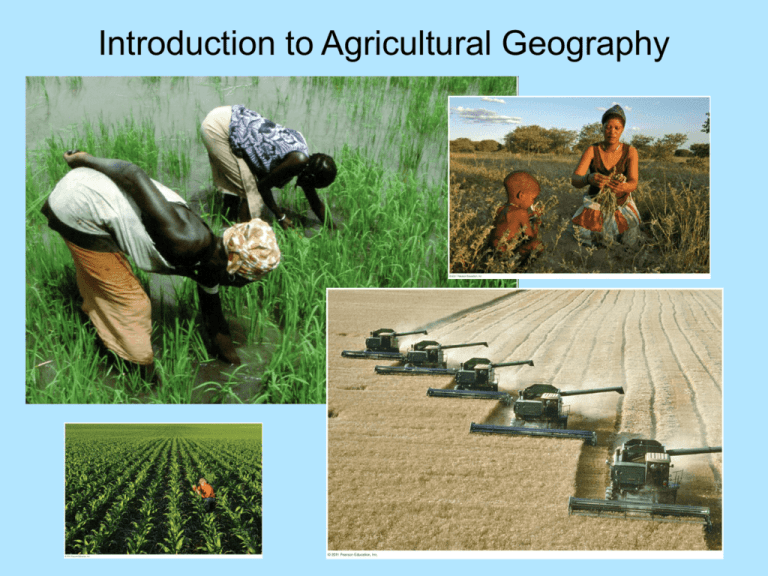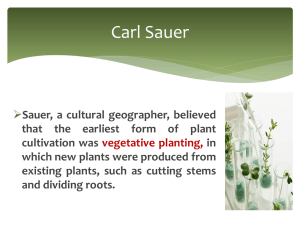
Introduction to Agricultural Geography
Agriculture: the deliberate modification of Earth’s
surface through the cultivation of plants and rearing of
animals to obtain sustenance or economic gain.
Banaue Rice Terraces, Philippines
Agriculture has been traditionally considered the dominant primary
sector activity. How does the modern commercial farmer pictured
above challenge this classification of agriculture as a purely primary
sector activity?
It was him, he did it!
About 200,000 years ago, we, (Homo sapiens) first appear in the
archeological record.
For the next 190,000 years
(or about 95% of our history)
we obtained our food through a
kind of nomadism known as
hunting and gathering.
Uncontacted Yonomami Village
(Venezuela/Brazil border)
Inuit
Amazonian
Tribes
San and Bantu peoples of
South Africa
Australian Interior:
Aborigines
Surviving Hunter Gatherer Populations
Sadly, these last remaining hunter gatherers are too small, isolated, and
politically weak stop the vicious stereotyping against them in the form of….
Ouch!
To avoid further unhealthy evolution…
The Paleo Diet!
(aka: “Eat like the hunter gatherer that you are!”)
Men probably did most of the hunting,
and they did it well.
In fact, the Pleistocene overkill theory argues
that after the end of the last ice age about
10,000 years ago, hunter-gatherers caused the
extinction of several large mammal species,
including the saber-toothed tiger, the woolly
mammoth, and the giant ground sloth.
Deexinctable? The Siberian Woolly Mammoth Clone Project
Women probably did most of the gathering.
This means women were likely the first to cultivate plants and
therefore the first to make the jump from harvesting wild plants to
planting them purposefully to be harvested later. In other words,
women probably played the major role in inventing agriculture.
But when and where did this so called First Agricultural (aka
Neolithic Revolution) first take place?
All contemporary discussions
(and most AP HG questions!)
about the origins of agriculture
begin with Carl Sauer's seminal
work, Agricultural Origins and
Dispersals, published in 1952.
Where else did we run into
Carl Sauer in this course?
He’s the Berkley
geographer who gave
us the concept of the
cultural landscape,
the visible human
imprint activity on the
landscape, which he
believed was the
proper focus for all
geographers.
Think of him as the
guy who put the nail
in the coffin of the
environmental
determinists.
Theories of Plant Domestication
Pre-Sauer
Sauer
SW Asia Hearth
Multiple hearths but 1st in SE Asia
Seed Agriculture (grains)
came first
Vegetative Planting (root crops)
came first.
Occurred in harsh
climates that forced
innovation due to
population pressure and
hunger
Rapid innovation
Occurred in areas of high
biodiversity (many habitats and
plant species). This allowed hunter
gatherers to become sedentary
which naturally lead to
experimentation with root crops.
Gradual innovation
10,000 years ago
14,000+ years ago
Location of Agricultural Hearths
Location of
agricultural hearths
Vegetative planting
(aka root cropping) is the
reproduction of plants by
direct cloning from
existing plants, such as
cutting stems and dividing
roots [Cassava (manioc or
yucca), yams, sweet
potatoes]
FIRST VEGETATIVE PLANTING: SE ASIA (?)
• According to Sauer, the earliest vegetative
agriculture appeared in Southeast Asia, and
probably involved root vegetables like taro and
yams, and perhaps tree crops like bananas.
• Vegetative agriculture then diffused throughout
Asia and eventually to the Near East and
Europe.
• Other, perhaps independent inventions took
place in West Africa (oil palm, yam) and South
America (manioc, arrowroot).
Sauer’s Three Hearth’s of Vegetative Planting:
SE Asia, West Africa, and Peruvian Highlands
Agricultural Origins and Regions
Location of
agricultural
hearths
Seed agriculture
the reproduction of
plants through annual
planting of seeds that
result from sexual
fertilization
rice
millet
sorghum
flax
barley
wheat
First Seed Planting: N. China, W. India, E. Africa (?)
• Seed Planting also had multiple hearths: Northern China,
Western India, Ethiopia
• Diffused rapidly from India into SW Asia (Fertile
Crescent) and then into Europe.
• Later independent hearths in Mexico and Northern Peru
• SW Asia, once thought to be the sole hearth of all kinds
of agriculture, still holds onto its title as the first place to
combine seed agriculture with the domestication of herd
animals (cattle, goats, pigs, sheep).
Sauer’s Three Hearth’s of Seed Agriculture:
Northern China, Western India, Ethiopia
(also later Mexico and Northern Peru
Animal Domestication
The best animals to farm are large, plant eating mammals.
Over the years, humans have probably tried to domesticate
all of them, usually without success. For example,
despite repeated efforts, Africans have never domesticated
the elephant.
Jared Diamond counted 148 different species of wild, plant
eating, terrestrial animals that weigh over 100 pounds. Of
those, we have only successfully farmed for any
length of time –just 14. They are: goats, sheep,
pigs, cows, horses, donkeys, Bactrian camels,
Arabian camels, water buffalos, llamas, reindeers,
yaks, mithans and Bali cattle. All but one of these
animals are native to Asia, North Africa and Europe. All
were domesticated at least 4500 years ago.
The Big Four livestock animals: cows, pigs, sheep and goats
were native to the SW Asia (Middle East/Fertile Crescent)
The Fertile Crescent
And now, an brief “archeology is cool moment”: Can 10,000 year
old gazelle teeth tell us something about when hunter gatherers
first settled down and started domesticating animals?
As it turns out, yes!
The outer layer of a
gazelle’s teeth at the
time of its death will
vary depending on what
it was eating during the
months before it died.
Archeologists studying the teeth of butchered gazelle in a
Natufian cave site in modern Israel that had been occupied by
homo sapiens from about 200,000 year ago, found that only after
around 10,000 BCE or so were gazelle eaten in the cave year
round, suggesting the date of earliest human sedentism (=staying
in one place.)
Proof of early agriculture in Fertile Crescent:
Natufian sickle (bone handle with microliths) c. 9000 BCE:
Takeaways: The First Agricultural Revolution
(aka Neolithic Revolution)
• South and Southeast Asia: Root crops, up to
14,000 years ago
• Southwest Asia (the Fertile Crescent): Seed
crops, about 10,000 years ago
• Why the “First” Agricultural Revolution…
Second Agricultural Revolution
• The Second Agricultural Revolution combined
innovations in farm machinery (seed drill,
McCormick Reaper), livestock breeding, and land
consolidation (Enclosure Movement) to provide the
surplus fencing needed to feed the large urban
work force of the Industrial Revolution in Europe.
• Moved agriculture beyond subsistence to the
generation of surpluses.
© 2012 John Wiley & Sons, Inc. All rights
reserved.
The Third Agricultural Revolution
• Also called the Green Revolution.
• Dates back to the 1930s: agricultural scientists in the
American Midwest began experimenting with
technologically manipulated seed varieties to increase
crop yields.
• 1960s: the focal point of the Green Revolution shifted to
India (IR8).
• The Green Revolution brought new high-yield varieties of
wheat and corn from the United States to other parts of
the world, particularly South and Southeast Asia.
© 2012 John Wiley & Sons, Inc. All rights reserved.







